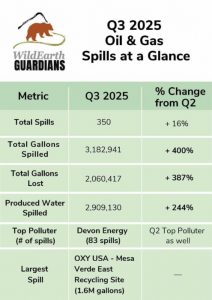
WildEarth Guardians Report Warns of Worsening Pollution Crisis
A new report by the environmental group, WildEarth Guardians, claims the number of oil and gas spills that occurred in the third quarter of the year in New Mexico soared 400%. It identified an Oklahoma company has one of the most frequent offenders.
The group said four of the five largest spills happened at produced water “recycling” facilities, exposing the risks of reusing toxic fracking waste. WildEarth Guardians stated in its findings that Oklahoma City’s Devon Energy along with ExxonMobil’s XTO were among the top offenders.
The Q3 2025 Waste Watch report documents 350 fluid spills between July 1 and September 30, including more than 2 million gallons of toxic waste “lost” to the environment, largely in the Permian Basin of southwest New Mexico. The findings confirm a dramatic escalation from both the Q1 and Q2 reports, which already showed steady increases in waste and wellsite mismanagement across state and federal lands.
“Toxic spills exploded nearly 400 percent this quarter—mostly on public lands,” said Melissa Troutman, Climate & Health Advocate and lead author of the report. “Produced water ‘recycling’ sites are becoming major polluters. Large contaminant ponds used for storage and treatment of produced water lead to much bigger spills.”

Devon Energy, XTO, and OXY USA Among Top Offenders
The report found that four of the five largest spills this quarter occurred at so-called produced-water “recycling” or reuse sites, where toxic wastewater is stored and treated for reuse in new drilling operations. The largest, on July 15, 2025, involved OXY USA’s Mesa Verde East site on federal public land, where equipment failure caused a spill of 1.6 million gallons of produced water and 126,000 gallons of crude oil, nearly all of which were lost to the environment.
“These ‘recycling’ facilities are ground zero for contamination,” said Troutman. “They prove what we’ve been warning regulators: you can’t safely reuse or discharge toxic oil and gas waste without putting water, land, and communities at risk.”
Over 60% of all spills occurred on federal lands, confirming that the Bureau of Land Management (BLM) and EPA continue to fail in enforcement.
- Devon Energy and ExxonMobil’s XTO topped the Worst Actors list for the third consecutive quarter.
- Eddy and Lea Counties (Permian Basin) accounted for 89% of all reported incidents.
Regulatory Debate Over Produced-Water Discharge
The surge in spills comes as the New Mexico Water Quality Control Commission (WQCC) considers a controversial new rule that would allow the discharge of treated produced water into the environment — the very waste responsible for this quarter’s biggest contamination events.
WildEarth Guardians and coalition partners previously won a strong discharge prohibition rule in May, which is now under appeal by industry. The current WQCC proceeding—backed by the Oil and Gas Association and “recycling” operators—seeks to roll back those protections.
“This data is Exhibit A in why the WQCC must reject the proposed produced water discharge rule sponsored by industry,” said Rebecca Sobel, Climate & Health Director at WildEarth Guardians. “If companies can’t safely contain produced water at their own recycling facilities inside the oilfield, there’s no justification for allowing them to transport this waste offsite to dump into rivers or spread onto fields.”
7.6 Million Gallons Spilled in 2025; Few Penalties Issued
Across all three quarters of 2025, more than 7.6 million gallons of oil and gas wastes and other contaminants have been spilled in New Mexico — equivalent to over 1,200 tanker trucks of toxic material. Yet no major fines or penalties have been issued to repeat violators. Trade-secret loopholes continue to hide chemical identities, making cleanup, worker protection, and medical response far more difficult and dangerous.
“The state’s produced-water ‘recycling’ experiment has turned public lands into toxic waste zones,” Sobel said. “Regulators have the authority—and obligation—to stop the next spill disaster before it happens.”
Background
WildEarth Guardians has been tracking and exposing the industry’s mounting pollution crisis throughout 2025:
- Q1 Waste Watch Report: Read here »
- Q2 Waste Watch Report: Read here »
- Top Polluter Report: “ExxonMobil Wins 2025 Top Polluter Award at Balloon Fiesta” »
- ExxtremeEnergy Campaign: See Guardians’ satirical exposé on industry greenwashing »
Together, these investigations and creative interventions expose how oil and gas waste pollution, lax enforcement, and corporate disinformation converge to endanger public health and water security in New Mexico.
WildEarth Guardians is urging state and federal policymakers to:
- Stop Toxic Waste Disasters — Require OCD, BLM, and EPA to issue meaningful fines, deny new permits to repeat offenders, and publicly report enforcement actions.
- Reject Produced-Water Discharge — Uphold the WQCC’s 2025 prohibition rule and reject any new rule that would legalize toxic discharge or “recycling” schemes.
- Mandate Full Chemical Disclosure — End trade-secret loopholes and require public disclosure of all drilling and fracking chemicals.
- Apply Hazardous Waste Laws — Remove oil and gas exemptions under RCRA, CERCLA, and the Safe Drinking Water Act, and classify produced water as hazardous waste.

